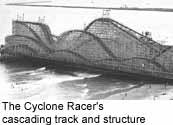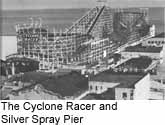|
Lost
Legends: Cyclone Racer
|
| |
Harry Traver is one of the
most renowned ride designers of all time. He is known for his work
on such legends as the Crystal Beach Cyclone and the Revere Beach
Lightning, and was involved in the construction of great rides like
the Riverview Bobs. But Harry Traver's personal favorite coaster was
his only dual track coaster, The Cyclone Racer. |
|
 |
Harry Traver spent much of
1929 designing and planning the The Cyclone Racer. Construction
began in early 1930. The pier the coaster was on was first built in
1914 to hold the Jack Rabbit roller coaster, and so the pier had no
deck underneath the coaster - you could see the water right through
the beams. Construction lasted five months and took over one million
board feet of lumber, over one million bolts, and 50 kegs of nails.
The coaster opened to the public on memorial day - May 30th - in
1930. Rising high above the rest of the rides, the coaster was the
centerpiece of The Pike, an amusement park that sat on a pier over
the shores of Long Beach, California. Its gorgeous white structure
and graceful curves occupied one whole side of the pier, and from
anywhere in the park you could see the trains gliding along the
ride's perfectly shaped trackwork. The ride had a certain perfection
about it. The racing trains changed lead seven times during the
circuit and still finished only seconds apart. The track was banked
perfectly, except where it was underbanked on purpose. The track was
designed and constructed so precisely that the passengers
experienced less than 0.1Gs five times during a circuit, but very
rarely pulled less than zero Gs. In other words, the airtime on this
coaster was perfect. And the whole ride was designed in the twenties
with no computers, or calculators. |
|
 |
The
coaster's loading station was forty feet wide and one
hundred and twenty feet deep and was surrounded by track. The whole
station would rumble whenever a pair of trains would race overhead.
After riders boarded the trains, the twin tracks turned away from
each other, and began climbing the lifts. The lift hills rose up to
a point, and met again at the top. From there the tracks turned
slightly to the left and dropped together at 49.5°, ducking under
and through its own structure at the bottom. After the thrilling
first drop, the ride entered the "ocean turn", a high speed turn
that was underbanked twenty degrees in order to give the sensation
that you were going to fly over the edge. Next, the tracks dipped
again and crossed over to the other side for another huge drop and a
rise into another turnaround. Then the tracks raced through the
overhead structure again, and back out to the far end of the pier
for a fast, swooping turn during which the inside track crossed over
to the outside. Then the coaster made a final run around the
perimeter of its structure before returning to the station. |
 |
|
 |
The Cyclone Racer, in addition to being one
of the greatest rides of all time, was also one of the most famous.
In fact, it was featured in many movies movies of its time. Eddie
Cantor got chased all over the pier, including the coaster, in
"Strike Me Pink". Lou Costello was also chased over its structure in
"Abbot and Costello in Hollywood". In "The Dancing Masters", laurel
and Hardy took a double decker bus onboard the coaster. |
|
There are countless
interesting stories and facts about the Cyclone Racer. For example,
one man was so terrified after his first ride, that he demanded to
pay twice, claiming it was two rides - his first and his last.
Another good story comes from "Mr. Pike" Al Brown, who worked at the
pike for over seventy years until it closed in 1978. A drunken
sailor who rode the coaster in the 1930s stood up and was tossed out
by the violent lateral G forces during the ocean turn. He cleared
the pier completely and landed in the water. He swam in to the
shore, walked into the station, and asked for another ride because
he fell out. The operators let him take another ride. |
| |
A breakwater built in the
early forties, changed the ocean currents under the pier, and sand
began to accumulate under it. The sand eventually built up until the
twenty feet of clearance under the pier was reduced to only three.
The underside of the pier then had to be fenced off because of
people taking advantage of the privacy afforded by the low pier. |
| |
The Cyclone Racer's huge
station was illuminated by five hundred and one 25 watt light bulbs,
but during the war, the park had to unscrew all but one light bulb,
to avoid being bombed. The coaster made it through the war without
being damaged. In 1947, the coaster was to be torn down because its
lease was to expire. Luckily, the lease was extended twenty years,
and the coaster remained while the rest of the park and the pier
were torn down in early 1949. |
| |
The coaster survived the whole length of its
lease with only minor modifications. The ride was given fixed lap
bars in the late fifties (it had no restraints until then).
The new
21 year lease expired May 1,1968 but a special permit allowed the
right to continue operation until after the Labor Day holiday. At
eleven o'clock PM on September fifteenth, 1968, the last of the
twenty five million people to ride the Cyclone Racer over it's 38
year reign boarded a train and had one last ride. Demolition of the
ride began the following day. |
|
 |
Will we ever see a ride like
this again? Possibly. Although the Cyclone Racer's blueprints were
destroyed many years ago, there is a group that has spent years
reverse-engineering the blueprints from photos and video clips.
Classic Coasters, headed by Larry Osterhoudt, have successfully
recreated the Cyclone Racer's blueprints, and with luck, will soon
find a park willing to rebuild this great classic ride. CoasterGlobe
would like to thank Larry Osterhoudt for his help with this article.
You can visit Classic Coasters' web
site at http://cycloneracer.com/. |
| |
Note: that the technical statistics
provided are
Copyright Classic Coasters, and are used on
CoasterGlobe with permission. This is the first
time that this data has been published. |
|
Statistics |
|
Height: |
26.5m (87') |
|
Length (each): |
1143m (3750') |
|
Max Speed: |
80kph (50mph) |
|
Ride Time: |
2:00 |
|
Inversions: |
0 |
|
Year: |
1930-1968 |
|
Designer: |
Harry Traver |
|
Type: |
Wood |
|
Layout: |
Triple Out and Back |
|
Restraints: |
Lap Bar |
|
Power: |
Chain Lift |
|
Max Vertical Gs: |
3.64 |
|
Cost: |
$150 thousand |
|
 |
Written by James Kay
All pages © Coasterglobe.com
All Data © 2001 Classic-Coasters
Layout diagram © Coasterglobe.com
Photos: WKVL
Special Thanks to Larry Osterhoudt
|